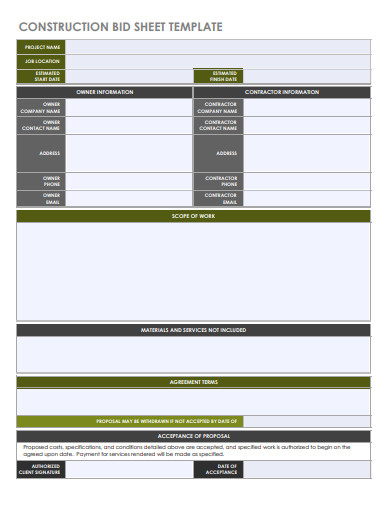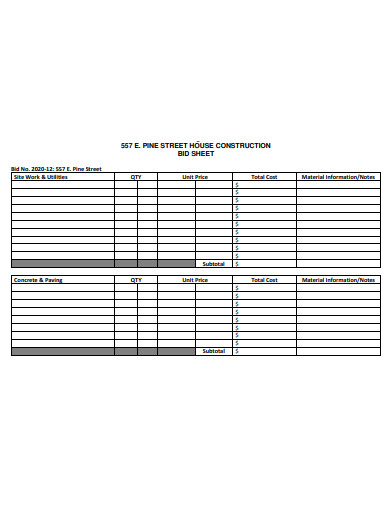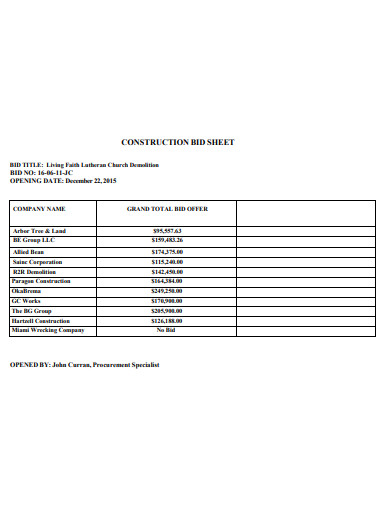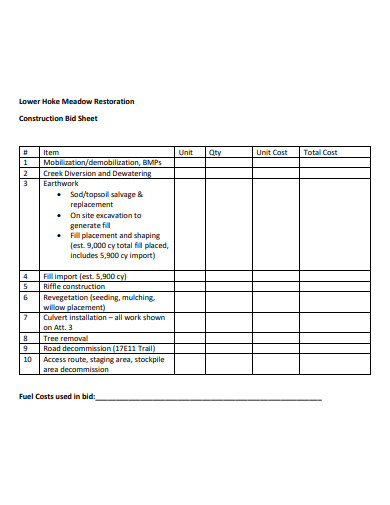Mastering the art of construction bidding is crucial for contractors aiming to secure lucrative projects. Our Sample Construction Bid Sheet serves as an indispensable tool, meticulously designed to guide professionals through every detail. With clear breakdowns and organized sections, this comprehensive sheet ensures you’re always equipped with the best data. Whether you’re a novice or an industry veteran, leverage our resource to sharpen your bidding strategy and elevate your project acquisitions.
5+ Construction Bid Sheet Samples
1. Construction Bid Worksheet Template
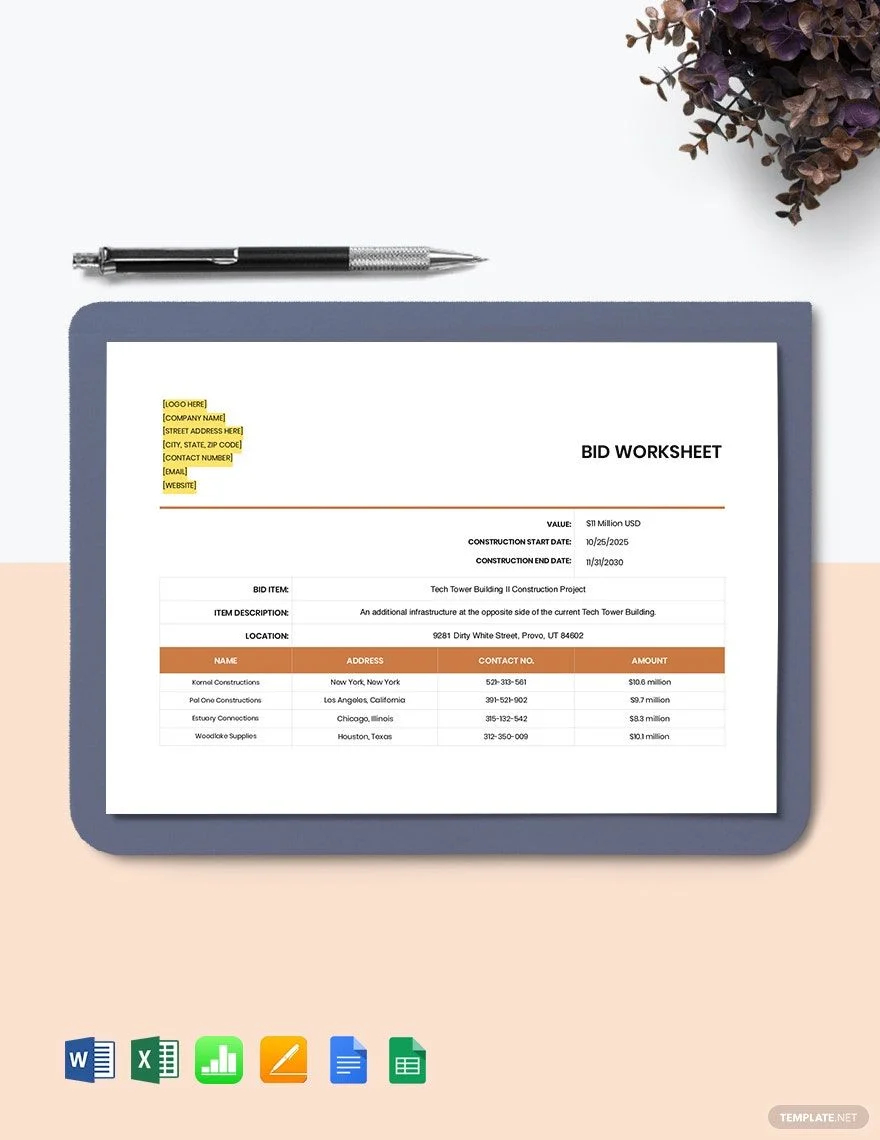
2. Contractor Bid Sheet Template
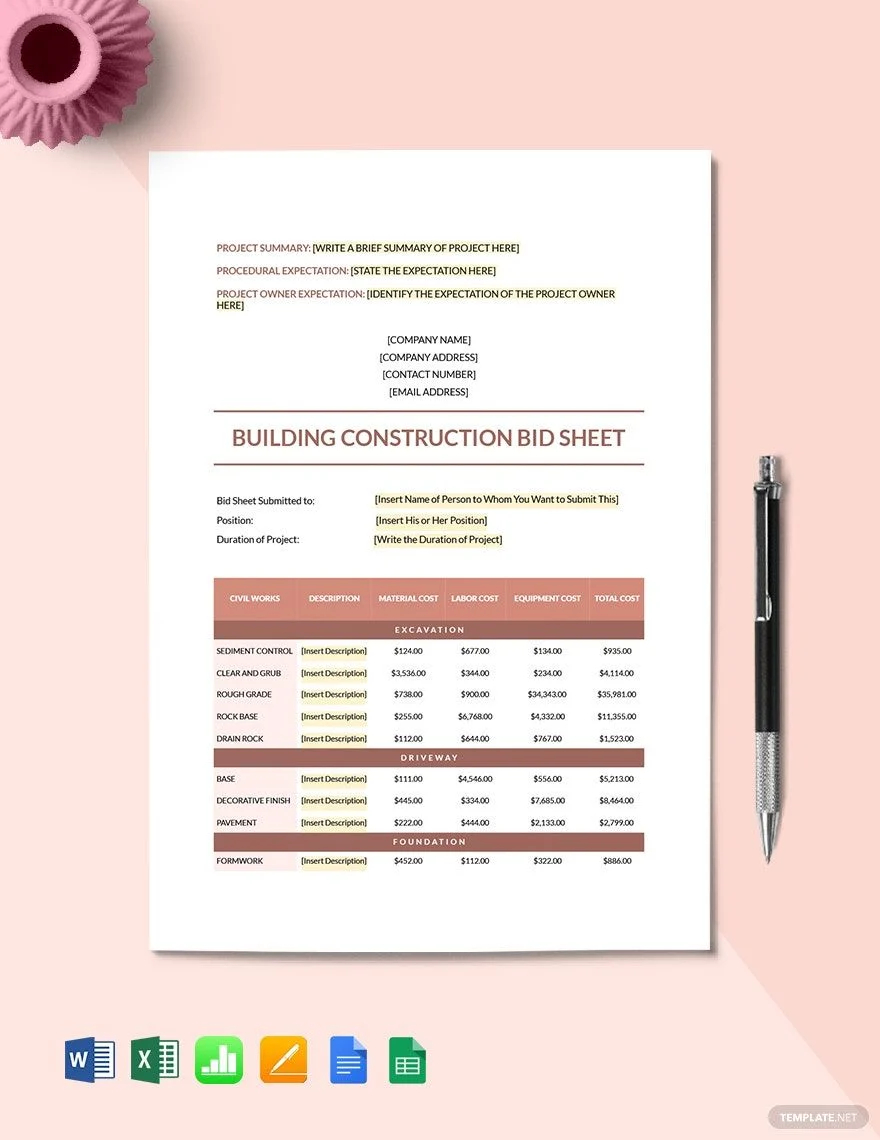
What is a Construction Bid Sheet?
A construction bid sheet, often simply referred to as a bid sheet, is a comprehensive document used by construction companies, contractors, and professionals to detail their proposal for a specific construction project. This sheet typically outlines the scope of work, the materials required, labor costs, and other relevant details that provide a clear picture of the costs and processes associated with the proposed project.
Understanding the Components
The heart of a construction bid sheet lies in its detailed components. These components not only give clarity about the project’s expectations but also help clients make informed decisions. Let’s delve into its core parts:
Scope of Work: This section provides an overview of the tasks and activities that will be carried out. It’s a high-level summary that offers insight into what the project entails, from inception to completion.
Materials Breakdown: Here, the subcontractor lists out all the necessary materials, their quantities, and costs. This might include anything from bricks and cement to fixtures and fittings, depending on the nature of the construction project.
Labor Costs: Labor is often one of the most significant costs in construction projects. This section breaks down the estimated labor hours, types of labor required (like carpenters, masons, electricians), and their associated costs.
Subcontractors and Specialists: Some projects may require specialized skills or machinery that the primary contractor doesn’t possess. In such cases, subcontractors or specialists are hired. Their roles and responsibilities, and costs are enumerated in this section.
Timeline: A rough estimate of how long each phase of the project will take, ensuring that both the contractor and client have a mutual understanding of the project’s duration.
Terms and Conditions: This section mentions any specific terms that both parties should be aware of, like payment milestones, potential penalties for delays, and any warranties or guarantees on the work.
Benefits of a Bid Sheet
Using a construction bid sheet benefits both the contractor and the client:
For contractors, it helps in presenting a clear, organized proposal, showcasing their professionalism and attention to detail.
For clients, it provides a transparent breakdown of costs, ensuring they understand where their money is going and helping them compare bids more effectively.
How do I Make a Bid Sheet for Construction?
Creating a construction bid sheet requires a combination of industry knowledge, attention to detail, and clarity in communication. Here’s a step-by-step guide:
Gather Project Details
Before drafting your bid sheet, gather all relevant project details. Understand the project’s scope, any specific client requirements, potential challenges, and any other pertinent information.
Draft the Scope of Work
Begin by detailing the scope of the project. This should be a clear, concise summary of what the project entails, from start to finish. Ensure you cover all the bases to prevent any ambiguity.
List Out Materials
Once you’ve detailed the scope, list out all the materials you’ll need. Be exhaustive in your list, mentioning quantities and costs. Always keep a buffer for any unforeseen requirements or cost escalations.
Estimate Labor Costs
Factor in the manpower required. This includes both skilled and unskilled labor. Estimate the hours or days each team or individual will work and multiply it by their hourly or daily rates.
Include Subcontractors
If you’re planning to hire subcontractors or specialists, mention them. Detail out their roles, the estimated time they’d require, and their costs.
Provide a Timeline
Offer a tentative timeline for the project. Break down the timeline into different project phases and provide start and end dates for each phase.
Mention Terms and Conditions
Clearly state the terms of the project. This could include payment terms, potential penalties, guarantees, and more. This section is crucial to protect both parties’ interests and set clear expectations.
Review and Revise
Before finalizing your bid sheet, review it thoroughly. Ensure all costs are accurate, all sections are detailed, and there’s no ambiguity. It’s also a good idea to have a colleague or industry peer review the sheet for an added layer of accuracy.
Remember, your bid sheet is a reflection of your professionalism and expertise in the field. Make sure it’s comprehensive, transparent, and communicates your capabilities effectively.
3. Construction Bid Sheet Template
4. House Construction Bid Sheet Template
5. Sample Construction Bid Sheet Template
6. Formal Construction Bid Sheet Template
Why Use a Construction Bid Template?
In the realm of construction, bidding can be a competitive and intricate process. That’s where the utility of a construction bid template comes into play. But why should contractors and companies use one? Let’s delve into the myriad of reasons that underscore its significance.
Streamlined Process
Having a standardized template can significantly streamline the bidding process. Rather than starting from scratch every time, a well-structured template provides a foundation, ensuring that all critical elements are consistently covered. This not only saves time but also reduces the chances of omitting crucial information.
Professional Presentation
First impressions matter, especially in the competitive world of construction bids. A well-organized, clear, and professional-looking template can make all the difference. When potential clients review your bid, a polished presentation can instill confidence, showcasing your commitment to precision and excellence.
Consistency Across Bids
For construction companies that handle multiple bids simultaneously or in succession, a template ensures consistency. This means that all stakeholders, be it team members or clients, know what to expect and where to find specific information. It makes internal collaboration easier and external communication clearer.
Error Minimization
Templates act as a checklist. By following a set structure, the likelihood of missing out on any key data or figures diminishes. This is particularly crucial in an industry where bids can be won or lost based on minute details.
Flexibility and Customization
While templates offer a standardized approach, they are not rigid. They can be customized to suit specific projects or clients, allowing contractors the flexibility to adjust as per the situation, all while maintaining a core structure.
Educational Tool for New Employees
For newcomers in a construction firm, a construction bid template serves as a valuable educational tool. It offers them insights into the company’s bidding approach, what information is deemed essential, and how to present it coherently.
How Do You Structure a Bid?
Crafting a winning construction bid requires more than just accurate numbers; it’s about presenting information in a structured and comprehensible manner. Let’s explore the anatomy of a well-structured bid.
Introductory Overview
Start with a brief introduction. This section should provide an overview of your company, its history, values, and past successes. Essentially, set the stage for why your firm is the right choice for the project.
Project Understanding
Before diving into the specifics, outline your understanding of the project. Describe the client’s requirements as you perceive them. This reassures the client that you’ve done your homework and understand their vision.
Detailed Scope of Work
Enumerate the tasks and activities you plan to undertake. Describe each phase of the project in detail, highlighting the processes involved, and the goals for each stage.
Materials and Cost Breakdown
Present a detailed list of all materials required, including quantities and costs. This provides transparency to the client and showcases your thoroughness.
Labor Estimations
Detail the labor involved. This should include types of workers, their respective roles, hours, and costs. Break it down in a way that the client can easily understand the manpower dynamics of the project.
Subcontractors Information
If subcontractors are involved, list them out. Describe their roles, expertise, and the specific tasks or phases they’ll be responsible for.
Project Timeline
Provide a tentative timeline, breaking it down into various phases or milestones. Highlight start and end dates, ensuring clients have a clear picture of the project’s progression.
Terms, Conditions, and Warranties
Clearly state any specific terms and conditions, including payment milestones, potential penalties, and any guarantees or warranties on the work done.
Final Summary and Call to Action
Conclude with a brief summary of the bid, reiterating your commitment to quality and efficiency. End with a call to action, inviting the client to reach out with questions or to take the next steps.
Remember, the key to a successful bid isn’t just in the numbers, but in the clarity, structure, and professionalism with which those numbers and details are presented.
Related Posts
FREE 12+ Balance Sheet Formats in MS Word | PDF | Excel
FREE 15+ Construction Timesheet Samples in PDF | MS Word
FREE 26+ Construction Sheet Samples in MS Word | Google Docs | Excel
FREE 20+ Continuation Sheet Samples in PDF | MS Word
FREE 25+ Program Sheet Samples in MS Word | Google Docs | Pages | PDF
FREE 33+ Student Sheet Samples in PDF | MS Word
FREE 32+ Planning Sheet Samples in PDF | MS Word
FREE 10+ OC Sheet Samples in PDF
FREE 10+ Beat Sheet Samples in PDF
FREE 3+ Paper Sign Up Sheet Samples in PDF
FREE 50+ Summary Sheet Samples in MS Word | Google Docs | Google Sheets | Excel | PDF
FREE 10+ Cleaning Bid Sheet Samples [ Commercial, House, Residential ]
FREE 10+ Group Sheet Samples in PDF
FREE 10+ Family Group Sheet Samples in PDF
FREE 5+ Printable Blank Signing in Sheet Samples in PDF

